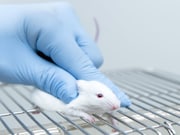
THURSDAY, Dec. 13, 2018 — A brain protein linked to Alzheimer’s disease might potentially be transmitted to people during neurological procedures, a new preliminary study suggests.
Genetically engineered lab mice developed amyloid-beta deposits in their brains after they were injected with amyloid-laced samples of human growth hormone taken from decades-old human cadavers, researchers found.
“We have now provided experimental evidence to support our hypothesis that amyloid-beta pathology can be transmitted to people from contaminated materials,” said senior researcher Dr. John Collinge. He is head of University College London’s department of neurodegenerative disease.
Clumps of amyloid-beta in the brain are a hallmark of Alzheimer’s disease, although researchers still don’t understand the relationship between these clumps and the degenerative brain disease.
Collinge pointedly noted that this study does not mean that you can catch Alzheimer’s from another person. And animal findings often don’t replicate in humans.
“Although we’re generating evidence that Alzheimer’s pathology may be transmissible, there’s absolutely no suggestion that Alzheimer’s disease itself is a contagious disease,” he said.
Rebecca Edelmayer, director of scientific engagement at the Alzheimer’s Association, went even further, noting that the new study did not look at Alzheimer’s disease at all.
“They’re looking at a buildup of amyloid in the brain, which is not the same thing as Alzheimer’s,” Edelmayer said.
“This is very, very preliminary research,” she added. “It’s very interesting, but preliminary.”
The mouse study is the latest chapter in a decades-long saga involving contaminated cadaver-derived human growth hormone (c-HGH).
Between 1958 and 1985, about 30,000 children with growth deficiencies were treated with human growth hormone drawn from the pituitary glands of corpses, scientists explained in an editorial accompanying the new study.
In 1985, three of these children were diagnosed with Creutzfeldt-Jakob disease (CJD), a fatal illness that causes progressive and irreversible brain damage.
The use of cadaver-derived HGH was subsequently abandoned. Doctors now prescribe a synthetic form of human growth hormone.
Overall, more than 200 people treated with c-HGH worldwide have died of CJD, the researchers said.
In 2015, Collinge and his colleagues reported that these c-HGH injections appeared to have “seeded” amyloid-beta into the brains of at least some of the patients.
Amyloid-beta deposits were found in six out of eight autopsied brains of people who died of CJD after receiving injections of c-HGH, the researchers noted.
In the latest study, his team wanted to make sure c-HGH was the true culprit behind the amyloid-beta deposits. So, they tracked down some of the original batches with which patients had been treated and tested them. The investigators found that some of the samples did have significant levels of amyloid-beta proteins.
The scientists then injected the tainted c-HGH into lab mice that had been genetically engineered to process the protein in the same way as humans.
“I was rather amazed we could seed so easily from this material, which had sat around at room temperature as a dry powder for 30 or 40 years,” Collinge said. “It showed the persistence of these seeds to degradation.”
The findings were published Dec. 13 in the journal Nature.
Collinge said his main concern from these findings is the potential of contaminated surgical equipment to transfer amyloid-beta between people.
“I think any risk from that would likely be small. I certainly wouldn’t want to discourage anybody from having neurosurgery,” Collinge said. “We need to develop new means of removing these seeds from instruments so any small risk that is there is removed, and we prevent any transmission by that route.”
The potential risk of amyloid-beta transmission through blood transfusion also should be re-examined, he said, although it’s not cause for alarm.
“People have looked at that in the past and have not found any association between blood transfusion and Alzheimer’s disease, but I think it wouldn’t be unreasonable to do further studies in that regard,” Collinge said.
“I think transfusion is probably not a major concern for me,” he continued. “I can’t absolutely rule it out, but I think it’s unlikely to be much of a problem. I’m more concerned about neurosurgical instruments and making sure we clean those thoroughly.”
More information
The U.S. Centers for Disease Control and Prevention has more about Creutzfeldt-Jakob disease.

© 2018 HealthDay. All rights reserved.
Posted: December 2018
